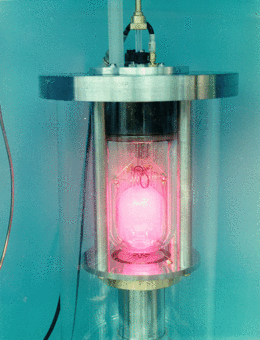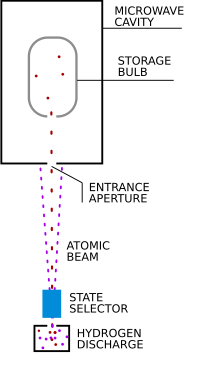Maser

A maser is a device that produces coherent electromagnetic waves through amplification by stimulated emission. Historically, “maser” derives from the original, upper-case acronym MASER, which stands for "Microwave Amplification by Stimulated Emission of Radiation". The lower-case usage arose from technological development having rendered the original definition imprecise, because contemporary masers emit EM waves (microwave and radio frequencies) across a broader band of the electromagnetic spectrum; thus, the physicist Charles H. Townes’ suggested usage of “molecular” replacing “microwave”, for contemporary linguistic accuracy.[1] In 1957, when the optical coherent oscillator was first developed, it was denominated optical maser, but usually called laser (Light Amplification by Stimulated Emission of Radiation), the acronym Gordon Gould established in 1957.
History
The theoretical principles describing the operation of a maser was described by Nikolay Basov and Alexander Prokhorov from Lebedev Institute of Physics at an All-Union Conference on Radio-Spectroscopy held by USSR Academy of Sciences in May 1952.
The results were subsequently published in October 1954. A precursor of the maser was the first show boosted hydrogen device built and tested by physicists Theodor V. Ionescu and Vasile Mihu in 1946. Independently, Charles H. Townes, J. P. Gordon, and H. J. Zeiger built the first ammonia maser at Columbia University in 1953. The device used stimulated emission in a stream of energized ammonia molecules to produce amplification of microwaves at a frequency of 24 gigahertz.
Townes later worked with Arthur L. Schawlow to describe the principle of the optical maser, or laser, which Theodore H. Maiman first demonstrated in 1960. For their research in this field Townes, Basov, and Prokhorov were awarded the Nobel Prize in Physics in 1964.
Technology
The maser is based on the principle of stimulated emission proposed by Albert Einstein in 1917. When atoms have been induced into an excited energy state, they can amplify radiation at the proper frequency. By putting such an amplifying medium in a resonant cavity, feedback is created that can produce coherent radiation.
Some common types of masers
- Atomic beam masers
- Ammonia maser
- Free electron maser
- Hydrogen maser
- Gas masers
- Rubidium maser
- Solid state masers
- Ruby maser
- Whispering-gallery modes iron-sapphire maser
The dual noble gas of a masing medium which is nonpolar.[2]
Recent developments
In 2012, a research team from the National Physical Laboratory and Imperial College London has found a way to have a solid-state maser operate at room temperature using pentacene-doped p-Terphenyl as the amplifier medium.[3] This could lead to a renewal of the maser technology into a wide range of applications.
Uses
Masers serve as high precision frequency references. These "atomic frequency standards" are one of the many forms of atomic clocks. They are also used as electronic amplifiers in radio telescopes. Masers are being developed as directed-energy weapons.
Hydrogen maser

Today, the most important type of maser is the hydrogen maser which is currently used as an atomic frequency standard. Together with other types of atomic clocks, they constitute the "Temps Atomique International" or TAI. This is the international time scale, which is coordinated by the Bureau International des Poids et Mesures, or BIPM.
It was Norman Ramsey and his colleagues who first realized this device. Today's masers are identical to the original design. The maser oscillation relies on stimulated emission between two hyperfine levels of atomic hydrogen. Here is a brief description of how it works:
- First, a beam of atomic hydrogen is produced. This is done by submitting the gas at low pressure to a high-frequency radio wave discharge (see the picture on this page).
- The next step is "state selection"—in order to get some stimulated emission, it is necessary to create a population inversion of the atoms. This is done in a way that is very similar to the famous Stern-Gerlach experiment. After passing through an aperture and a magnetic field, many of the atoms in the beam are left in the upper energy level of the lasing transition. From this state, the atoms can decay to the lower state and emit some microwave radiation.
- A high quality factor microwave cavity confines the microwaves and reinjects them repeatedly into the atom beam. The stimulated emission amplifies the microwaves on each pass through the beam. This combination of amplification and feedback is what defines all oscillators. The resonant frequency of the microwave cavity is exactly tuned to the hyperfine structure of hydrogen: 1420 405 751.768 Hz.
- A small fraction of the signal in the microwave cavity is coupled into a coaxial cable and then sent to a coherent radio receiver.
- The microwave signal coming out of the maser is very weak (a few pW). The frequency of the signal is fixed and extremely stable. The coherent receiver is used to amplify the signal and change the frequency. This is done using a series of phase-locked loops and a high performance quartz oscillator.
Astrophysical masers
Maser-like stimulated emission has also been observed in nature from interstellar space, and it is frequently called "superradiant emission" to distinguish it from laboratory masers. Such emission is observed from molecules such as water (H2O), hydroxyl radicals (OH), methanol (CH3OH), formaldehyde (CH2O), and silicon monoxide (SiO). Water molecules in star-forming regions can undergo a population inversion and emit radiation at about 22.0 GHz, creating the brightest spectral line in the radio universe. Some water masers also emit radiation from a vibrational mode at a frequency of about 96 gigahertz.
Extremely powerful masers, associated with active galactic nuclei, are known as megamasers and are up to a million times more powerful than stellar masers.
Terminology
The meaning of the term maser has changed slightly since its introduction. Initially the acronym was universally given as "microwave amplification by stimulated emission of radiation," which described devices which emitted in the microwave region of the electromagnetic spectrum.
The principle and concept of stimulated emission has since been extended to more devices and frequencies. Thus the original acronym is sometimes modified, as suggested by Charles H. Townes,[1] to "molecular amplification by stimulated emission of radiation." Some have asserted that Townes's efforts to extend the acronym in this way were primarily motivated by the desire to increase the importance of his invention, and his reputation in the scientific community.[4]
When the laser was developed, Townes and Schawlow and their colleagues at Bell Labs pushed the use of the term optical maser, but this was largely abandoned in favor of laser, coined by their rival Gordon Gould.[5] In modern usage, devices that emit in the X-ray through infrared portions of the spectrum are typically called lasers, and devices that emit in the microwave region and below are commonly called masers, regardless of whether they emit microwaves or other frequencies.
Gould originally proposed distinct names for devices that emit in each portion of the spectrum, including grasers (gamma ray lasers), xasers (x-ray lasers), uvasers (ultraviolet lasers), lasers (visible lasers), irasers (infrared lasers), masers (microwave masers), and rasers (RF masers). Most of these terms never caught on, however, and all have now become (apart from in science fiction) obsolete except for maser and laser.
During the early 1960s, the Jet Propulsion Laboratory developed a maser to provide ultra-low-noise amplification of S-band microwave signals received from deep space probes. This maser used deeply refrigerated hydrogen to chill the amplifier down to a temperature of four degrees kelvin. Amplification was achieved by exciting a ruby comb with a 12.0 gigahertz klystron. In the early years, it took days to chill, and remove the impurities from, the hydrogen lines. Refrigeration was a two-stage process with a large Linde unit on the ground, and a crosshead compressor within the antenna. The final injection was at 3000 pounds per square inch through a six thousanths of an inch, micrometer adjustable, entry to the chamber. The whole system noise temperature looking at cold sky [2.7 kelvins was 17 kelvins. This gave such a low noise figure that the Mariner IV space probe could send still pictures from Mars back to the Earth even though the output power of its radio transmitter was only 15 watts, and hence the total signal power received was only -169 decibels with respect to a milliwatt (dBm).
See also
References
- ^ a b Charles H. Townes – Nobel Lecture
- ^ The Dual Noble Gas Maser, Harvard University, Department of Physics
- ^ Attention: This template ({{cite doi}}) is deprecated. To cite the publication identified by doi:10.1038/nature.2012.11199, please use {{cite journal}} (if it was published in a bona fide academic journal, otherwise {{cite report}} with
|doi=10.1038/nature.2012.11199instead. - ^ Taylor, Nick (2000). LASER: The inventor, the Nobel laureate, and the thirty-year patent war. New York: Simon & Schuster. ISBN 0-684-83515-0.
- ^ Taylor, Nick (2000). LASER: The inventor, the Nobel laureate, and the thirty-year patent war. New York: Simon & Schuster. pp. 66–70. ISBN 0-684-83515-0.
Further reading
- J.R. Singer, Masers, John Whiley and Sons Inc., 1959.
- J. Vanier, C. Audoin, The Quantum Physics of Atomic Frequency Standards, Adam Hilger, Bristol, 1989.
External links
- arXiv.org search for "maser"
- Noble gas Maser
- "The Hydrogen Maser Clock Project". Harvard-Smithsonian Center for Astrophysics. Archived from the original on 2006-10-10.
- Bright Idea: The First Lasers
- Invention of the Maser and Laser, American Physical Society
- Shawlow and Townes Invent the Laser, Bell Labs
